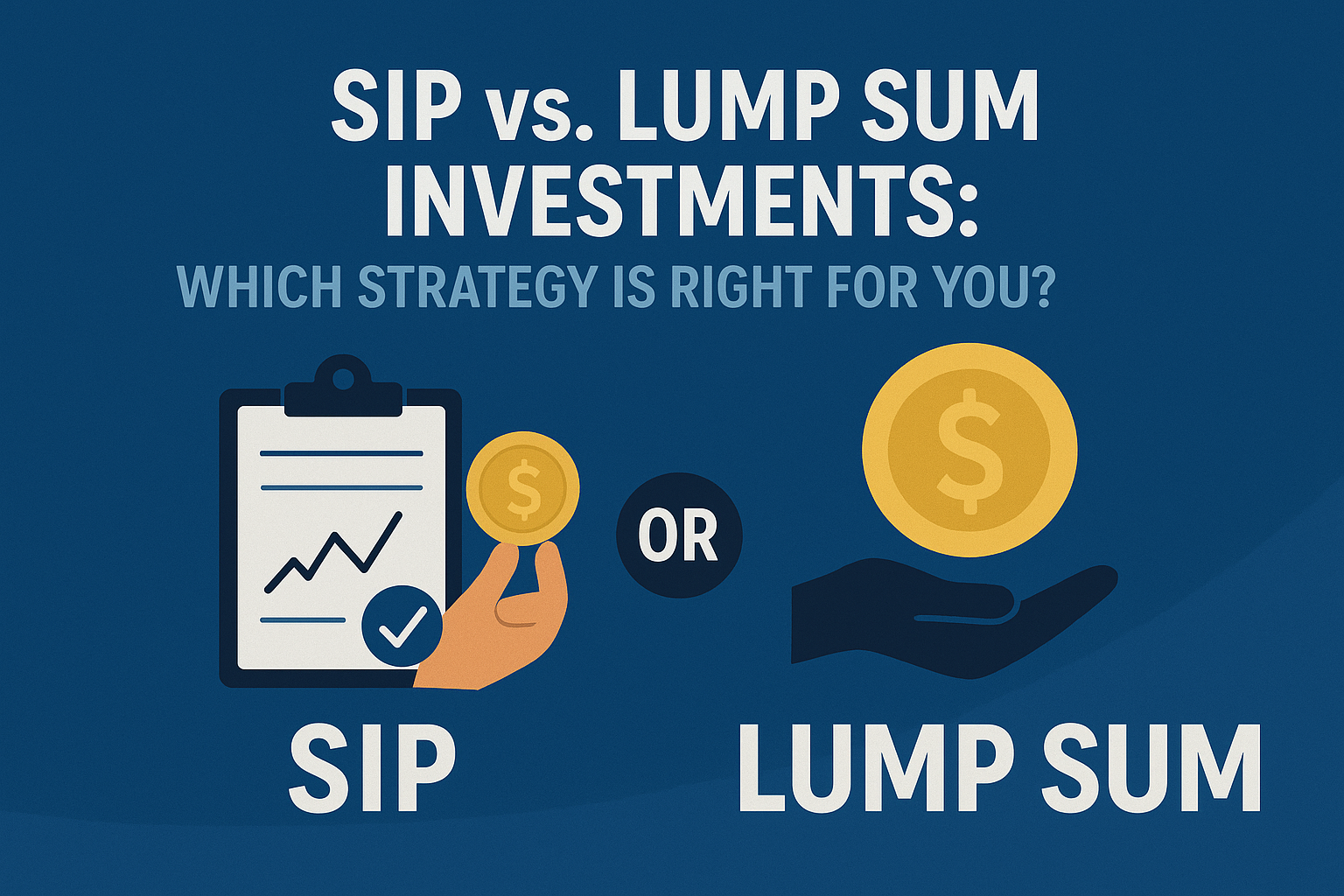When it comes to investing, one of the most common questions investors face is:
Should I invest through a Systematic Investment Plan (SIP) or make a lump sum investment?
Both methods have their merits, and choosing the right one can significantly impact your long-term wealth creation.
As an experienced SIP vs lump sum investment advisor, I can tell you there’s no one-size-fits-all answer. Your choice depends on factors like market conditions, financial goals, risk tolerance, and investment horizon.
In this article, we’ll break down both approaches in detail, compare their advantages and drawbacks, and help you decide which strategy works best for you.
What is SIP (Systematic Investment Plan)?
A Systematic Investment Plan (SIP) is a disciplined way of investing where you contribute a fixed amount into a mutual fund or other investment vehicle at regular intervals (monthly, quarterly, etc.).
Instead of trying to time the market, SIP allows you to average out your purchase cost over time. This is known as rupee cost averaging, which can be a powerful strategy for long-term investors.
Example:
If you invest ₹10,000 every month in an equity mutual fund, you buy more units when the market is down and fewer units when it’s up—helping smooth out volatility.
What is Lump Sum Investment?
A lump sum investment means investing a large amount of money all at once. This is ideal if you have a significant amount of idle funds—say from a bonus, inheritance, or asset sale—and want to put it to work immediately.
With lump sum investing, your entire capital starts compounding from day one. This can be advantageous in a rising market but can also expose you to higher short-term volatility.
SIP vs Lump Sum: A Quick Comparison Table
| Factor | SIP | Lump Sum |
|---|---|---|
| Investment Amount | Small, fixed amounts periodically | Large amount at once |
| Risk Management | Lower risk due to averaging | Higher risk if market falls soon after |
| Market Timing | Not required | Crucial for optimal returns |
| Discipline | Encourages regular saving habits | Requires one-time decision |
| Best for | Salaried individuals, new investors | Investors with idle lump sum funds |
| Flexibility | High (can pause or adjust amounts) | Low once invested |
Advantages of SIP
1. Rupee Cost Averaging
SIP automatically buys more units when prices are low and fewer when prices are high, lowering your average cost per unit over time.
2. No Need for Market Timing
You don’t have to worry about predicting market highs and lows—investments are made at regular intervals.
3. Encourages Financial Discipline
SIP turns investing into a habit, making it easier to stick to long-term goals.
4. Flexibility
You can increase, decrease, or pause your SIP anytime without heavy penalties.
5. Ideal for Small Investors
Even with ₹500–₹1000 per month, you can start building wealth steadily.
Disadvantages of SIP
- Returns may be lower than lump sum if the market consistently rises after you start.
- It requires patience; significant results appear only over long periods.
- Frequent small transactions can feel slow for investors with larger capital.
Advantages of Lump Sum Investment
1. Immediate Market Exposure
Your full investment starts working and compounding right away.
2. Higher Returns in Bull Markets
If the market is in an uptrend, lump sum investing can generate higher short-term returns compared to SIP.
3. Suitable for Large Funds
Perfect for investors who receive bonuses, inheritances, or asset sale proceeds.
Disadvantages of Lump Sum Investment
- High Market Timing Risk – If invested just before a market crash, losses can be significant.
- Emotional Stress – Large fluctuations in the value of your investment can lead to panic selling.
- Not Beginner-Friendly – Requires market knowledge and risk appetite.
When to Choose SIP Over Lump Sum
Choose SIP if:
- You have a steady income but no large surplus funds.
- You want to reduce market timing risk.
- You are a first-time investor seeking a disciplined approach.
- You prefer to invest small amounts regularly without financial strain.
When to Choose Lump Sum Over SIP
Choose Lump Sum if:
- You have idle funds you want to invest immediately.
- The market is undervalued or at a strong upward trend.
- You have high risk tolerance and experience in market investing.
- You want faster compounding of a large capital.
Hybrid Approach: Combining SIP and Lump Sum
Many SIP vs lump sum investment advisors recommend blending both strategies.
Example:
If you have ₹5,00,000 to invest, you could:
- Invest ₹3,00,000 lump sum right away to take advantage of compounding.
- Put the remaining ₹2,00,000 into a 12-month SIP to average out market fluctuations.
This approach offers growth potential + risk control.
Tax Implications
Whether you invest via SIP or lump sum, the tax treatment depends on the type of fund:
- Equity Mutual Funds:
- STCG (Short-Term Capital Gains) – 15% if sold before 1 year
- LTCG (Long-Term Capital Gains) – 10% above ₹1 lakh per year after 1 year
- Debt Mutual Funds:
- Gains taxed as per slab rate (post-April 2023 rules in India)
Pro Tip: Consult an investment advisor to choose tax-efficient funds.
Real-Life Example: SIP vs Lump Sum Over 10 Years
Let’s assume:
- SIP: ₹10,000 per month for 10 years in a fund with 12% annualized returns
- Lump Sum: ₹12,00,000 invested once at 12% annualized returns
Results after 10 years:
| Method | Final Value | Total Invested | Profit |
|---|---|---|---|
| SIP | ₹23,23,391 | ₹12,00,000 | ₹11,23,391 |
| Lump Sum | ₹37,27,646 | ₹12,00,000 | ₹25,27,646 |
Insight: Lump sum delivers higher returns in a consistent bull market, but SIP provides smoother, less risky growth.
How a SIP vs Lump Sum Investment Advisor Can Help
An expert advisor can:
- Analyse your financial goals and risk appetite.
- Suggest a customized portfolio mix.
- Identify market opportunities for lump sum investing.
- Set up and monitor your SIPs for optimal performance.
- Help you rebalance your portfolio periodically.
Common Mistakes to Avoid
- Investing lump sum at market peaks without diversification.
- Stopping SIPs during market downturns (you miss out on lower prices).
- Not reviewing investments regularly with your advisor.
- Ignoring tax implications of redemptions.
Final Verdict: SIP or Lump Sum?
- If you’re risk-averse and prefer stability, SIP is your best bet.
- If you have large idle funds and can handle market swings, lump sum can be rewarding.
- If you want the best of both worlds, go for a hybrid strategy.
Still confused about SIP vs lump sum investments?
Speak to an expert SIP vs lump sum investment advisor today to get a personalized investment plan that matches your goals, risk profile, and market outlook.
Contact us now for a free consultation and start your journey towards financial freedom.


Leave a Reply